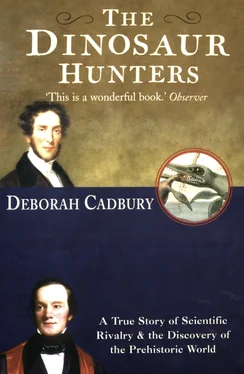
A Story of Scientific RivalryAnd the Discovery of thePrehistoric World
For my mother and Martin,
the first readers,
with love
Cover
Title Page
Dedication
PART ONE
1 An Ocean Turned to Stone
2 The World in a Pebble
3 Toast of Mice and Crocodiles for Tea
4 The Subterranean Forest
5 The Giant Saurians
PART TWO
6 The Young Contender
7 Satan’s Creatures
8 The Geological Age of Reptiles
9 Nature, Red in Tooth and Claw
10 Nil Desperandum
PART THREE
11 Dinosauria
12 The Arch-hater
13 Dinomania
14 Nature without God?
Epilogue
Notes and Sources
Select Bibliography
Index
Acknowledgements
About the Author
Praise
Other Works
Copyright
About the Publisher
PART ONE
1 An Ocean Turned to Stone
She sells sea-shells on the sea-shore,
The shells she sells are sea-shells, I’m sure
For if she sells sea-shells on the sea-shore
Then I’m sure she sells sea-shore shells.
Tongue-twister by Terry Sullivan, 1908,
associated with Mary Anning
On the south coast of England at Lyme Regis in Dorset, the cliffs tower over the surrounding landscape. The town hugs the coast under the lee of a hill that protects it from the south-westerly wind. To the west, the harbour is sheltered by the Cobb, a long, curling sea wall stretching out into the English Channel – the waves breaking ceaselessly along its perimeter. To the east, the boundary of the local graveyard clings to the disintegrating Church Cliffs, with lichen-covered gravestones jutting out to the sky at awkward angles. Beyond this runs the dark, forbidding crag face of Black Ven, damp from sea spray. The landscape then levels off across extensive sweeps of country, to where the cliffs dip to the town of Charmouth, before rising sharply again to form the great heights of Golden Cap.
At the beginning of the nineteenth century, according to local folklore, the stones on Lyme Bay were considered so distinctive that smugglers running ashore on ‘blind’ nights knew their whereabouts just from a handful of pebbles. However, it was not only smugglers and pirates who became familiar with the peculiarities of these famous cliffs. Through a series of coincidences and discoveries Lyme Bay soon became known as one of the main areas for fossil hunting. Locked in the layers of shale and limestone known as the ‘blue lias’ were the secrets of a vast, ancient ocean now turned to stone, the first clue to an unknown world.
In 1792, war erupted in Europe and it became dangerous for the English gentry to travel on the Continent. Many of the well-to-do classes adopted the resorts of the south coast of England. The dramatic scenery around Lyme Bay became a favourite among those who spent part of the season at Bath. In the summer, smart carriages often lined the Parade and the steep, narrow streets that nestled into the hillside. The novelist Jane Austen was among those who visited early in the nineteenth century. She was charmed by the High Street, ‘almost hurrying into the sea’, and ‘the very beautiful line of cliffs stretching out to the east’. The Cobb curving around the harbour became the dramatic setting for scenes in her new novel Persuasion. It was here that Louisa Musgrove fell ‘lifeless … her eyes closed, her face like death’, and was nursed back to health by the romantic sea captain.
Jane Austen’s letters to her sister, Cassandra, reveal that during her short stay she met an artisan in the town by the name of Richard Anning. He was summoned to value the broken lid of a box and, according to Jane Austen, was a sharp dealer. She told her sister that Anning’s estimate, at five shillings, was ‘beyond the value of all the furniture in the room together’.
Richard Anning, even as a skilled carpenter, struggled to make a living. The blockade of European ports during the Napoleonic Wars had caused severe food shortages. With no European corn available, the price of wheat had risen sharply, from 43 shillings a quarter in 1792 just before the war, to 126 shillings in 1812. Since bread and cheese was the staple diet for many in the southern counties, the spiralling price of a loaf caused great suffering. Wages did not rise during this period, and in many districts workers received a supplement from the parish to enable them to buy bread. Industrious labourers effectively became paupers relying on parish charity, and there was a real fear of starvation. While the gentry, glimpsed beyond sweeping parklands in their country estates, benefited from high prices and seemed impervious to the effects of war, the poor began to riot. The flaming rick or barn became a symbol of the times. Richard Anning was himself a ringleader of one protest over food shortages.
In rural Dorset, the poor were not only hungry, but with a shortage of fuel they also faced damp, cold conditions and sometimes worse. Richard Anning and his wife, Molly, lived in a cottage in a curious array of houses built on a bridge over the mouth of the River Lym. On one occasion, they awoke to find that ‘the ground floor of their home had been washed away during the night’. Their modest home had succumbed to an ‘exceptionally rough sea which had worked the havoc’.
The desire to keep warm could have lain behind a tragedy that befell the Annings’ eldest child, Mary, at Christmas in 1798. The event was reported starkly in the Bath Chronicle : ‘A child, four years of age, of Mr R. Anning, a cabinet maker of Lyme, was left by the mother about five minutes … in a room where there were some shavings by a fire … The girl’s clothes caught fire and she was so dreadfully burnt as to cause her death.’ Whether Mary was huddling too close to the flames for warmth, or accidentally stumbled, is not known. It is known, however, that her distraught mother, on the birth of their next daughter six months later, called her Mary in memory of her dead sister.
Naming a newborn after a child that had died was a common practice at a time when a quarter of poor infants died in their first year and half were dead before the age of five. Many were undernourished and readily succumbed to consumption, pneumonia, smallpox, measles or other diseases. Apart from the sudden death of their eldest daughter Mary, the Annings had already lost two other children, Martha and Henry, by the year 1800. But fate was to intervene in an unexpected way in the young life of the second Mary Anning.
That summer, when Mary was just one year old, news reached Lyme Regis that a touring company of riders was to perform near the town. Among the enticements were a display of vaulting, riding stunts and a lottery, with prizes such as copper tea-kettles and legs of mutton. The arrival of the travelling performers was a welcome distraction for the local inhabitants, and crowds of people trekked past the church and the gaol near the Annings’ house to the equestrian show, set in a field on the outskirts of town. Mary was taken along in the care of a local nurse, Mrs Elizabeth Hasking.
By late afternoon a heavy thunderstorm developed, but the crowds would not disperse, perhaps lingering to see who had won the lottery. Then, in the words of the local schoolmaster, George Roberts: ‘a vivid discharge of electric fluid ensued, followed by the most awful clap of thunder that any present ever remembered hearing, which re-echoed around the fine cliffs of Lyme Bay. All appeared deafened by the crash. After a momentary pause a man gave the alarm by pointing to a group that lay motionless under a tree.’
Читать дальше













